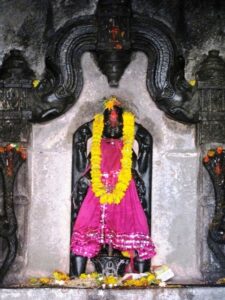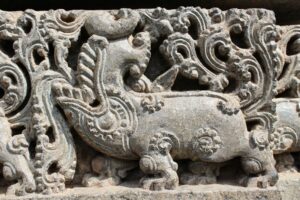Makara is legendary a sea-creature in Hindu culture. It is generally depicted as half terrestrial animal in the frontal part (stag, deer, crocodile, or elephant) and half aquatic animal in the hind part (usually a fish or seal tail, though sometimes a peacock or even a floral tail is depicted.) Makara take many different forms throughout Asia.’Makara’ is a Sanskrit word which means “sea dragon” or “water-monster”
In Hindu astrology, Makara is equivalent to the sign of Capricorn, tenth of the twelve symbols of the Zodiac.
Makara appears as the vahana (vehicle) of the river goddess Ganga, Narmada and of the sea god Varuna.
Makara are considered guardians of gateways and thresholds, protecting throne rooms as well as entryways to temples; it is the most commonly recurring creature in Hindu and Buddhist temple iconography, and also frequently appears as a Gargoyle or as a spout attached to a natural spring.
Makara ornaments are a popular traditional wedding gift for the bride; these makara-shaped earrings called Makarakundalas are sometimes worn by the Hindu Preserver-god Vishnu, the Sun god Surya, and the Mother Goddess Chandi. Makara is also the insignia of the love god Kamadeva, who has no dedicated temples and is also known as Makaradhvaja, “one whose flag depicts a makara”.
From the 2nd century BCE, the Makara appears to have been the symbol of Pradyumna, son of Vāsudeva Krishna. One of the epithets of Pradyumna in literature, such as in Harivamsa, is “Makaradhvaja”, meaning “he whose banner or standard is the crocodile”.
A row of makara may run along the wall of a Hindu temple, act as the hand rail of a staircase, or form an arch above a doorway.
Traditionally, a Makara is considered to be an aquatic mythical creature. Makara has been depicted typically as half mammal and half fish. Some traditional accounts identify it with a crocodile, specifically Gharial because of its long extended snout. It is depicted with the forequarters of an elephant and the hindquarters as a fish tail.
In the medieval era of South India, Makara symbolized in the form of an elephant head and body with an elaborately foliated fish tail. Most myths maintain this symbolism of this stage in the evolution of life.













